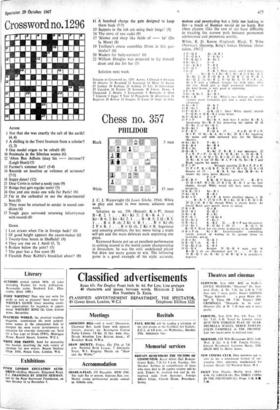Chess no. 357
PHILIDOR
Black White 5 men 13 men
J. C. J. Wainwright (St Louis Globe, 1914). White to play and mate in two moves; solution next week.
Solution to no. 356 (Bakesi): K x P!, threat B-R 2. 1 . .. Kt-Kt 5; 2 R-K 4. I
Kt - B 6; 2 Kt-Kt 2. 1 . . . B - R 5; 2 Q - B 5. 1...BxRch; 2 Kt x B.1...RxKtch; 2 P x R. 1 . . . R x Q ch, 2 Kt x R. Ingenious and amusing problem, the key move being a triple self-pin and the main defences each unpinning one piece.
Raymond Keene put up an excellent performance in coming second in the world junior championship at Jerusalem; he was the only undefeated player but drew too many games to win. The following game is a good example Of his style; accurate,
filature and penetrating but a little too lacking in fire-a touch of Busman would do no harm. But chess players (like the rest of us) have difficulty in treading the narrow path between permanent adolescence and premature senility.
White, R. D. Keene (England). Black, T. Wibe (Norway). Opening, King's Indian Defence. (Jeru- salem, 1967 3 2 P-QQ B4 P-K Kt 3 3 P - K Kt 3 B --Kt 2
4 B - Kt 2 0 - 0 5 Kt-K B 3 P-B4 6 P - Q 5 P - Q 3 7 0 - 0 P - K 3. More usual, and I think better, is 7 .Kt - R 3; 8 Kt - B 3. Ki - 11 2; 9 Kt - Q 2. R -Kt I; 10 P-Q R 4„ P-Q R 3: 11 P-R 5. Kt - Q 2: 12 Q - B 2, P - Q Kt 4; 13 P x P e.p., Kt x P with a difficult struggle for both sides. After the text, Black gets a slight positional inferiority of the
8 PXP kind Keene B X P is story good at exploiting.
9 Kt -K Kt 5 Kt - B 3
10 Kt x B P x Kt. White's two bishops and rather sounder :pawn formation give him a small but definite advantage.
12 R - Kt I X --R 1 Q - K 2 11 Kt - B 3
13 P- Q R 3 Q R- Q I. Since White dearly intends P- Q Kt 4, Q R -B 1 looks better.
14 P - Q Kt 4 .p P
15 P x P Xt - K 4. And here I prefer R - B I,
threatening Kt - K 4 but preserving the option (if 16 0 I( t t 33) of Kt -O 0 5. 16 0 (
R -B
17P-85' P- Q 4 17. . . P x P; 18 P x P, Q it P; 19 Kt - K 4, Kt it Kt; 20 B X Kt regaining the pawn and with increased play for the bishops (Keene).
18 Kt-Kt 5 P - Kt 3 19 B -B 4 Kt - R 4
20 B x Kt BxB
21 Q -X 3 B - Kt 2? B - B 3 was necessary. 22 P x P, P x P; 23 Q x P. Q R - Kt I; 24 Q-31 5, K - B 1; 26 Q x Q. B x Q; 27 Kt - Q 4. P - K
28 Et - K 6 (or 28 Kt -13 3, P -K '1). 'Kt -II 3 and 'Blank regains Ilk. ,pawn.
22 P x P7 . Wrongly rejecting 12 B X P. P x P;
23 PXP,RXQBP: 24 QxP, QxQ; 25 BxQ . because of 25. pawn - 4, but then 26 B - Kt 4 retains the extra pawn (Keene).
22._. .P P 23 B -R 31 K R -K. I? Keene gives 23 .. . R - B 5;
24 Q x IKP. 12 X Q; 25 B x Q. R- K 5 as the best chance, though White would still have some winning prospects.
24 K R - Q 1 Kt -B 3 25 Kt - Q 4 R - B 5 26 Kt x P R X P. A better practical chance is 26
. . R - K 5; 27 Q x .P. R x Kt; 28 B x R. Q x B: 29 Q x Q. R x Q; though White is clearly better. As played Black goes quietly down to defeat.
27 R x R Q x R 28 Q - B 1
Q -Q 3
29 Kt x 13 K x Xt
30 3-Kt 4
Q Kt 2 P - Kt 5 32 B - Kt 2 K - B 2. 32 . . II X P was threatened.
33 Q - Kt 3 R - Q Kt I. Or 33 . . R - 0 1; 34 R 4. Black has too many weaknesses to be defended. 34 BaPch Kt x B? Understandably committing suicide instead of waiting to be ground down to inevitable defeat.
35 R x Kt Q - K 3 36 R -Q 7 ch K - 13 3 37 Q - Kt 2 ch K - B 4 38 Q - Q 4 Resigns. 39 Q - B 4 mate and 39 112 - Q S ch are threatened and 38 . . . P - Kt 4; 39 R - Q 5 ch. K - Kt 3; 40 R - Q 6 is completely hopeless.


































 Previous page
Previous page